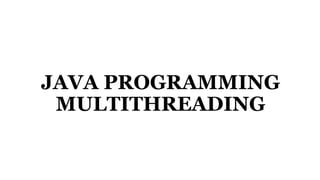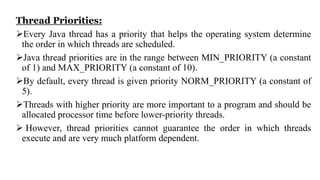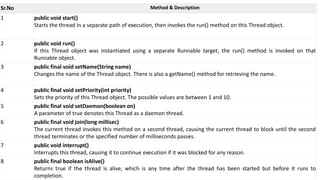Multithreading in java
- 2. MULTITHREADING Java is a multi-threaded programming language which means we can develop multi- threaded program using Java. A multi-threaded program contains two or more parts that can run concurrently and each part can handle a different task at the same time making optimal use of the available resources specially when your computer has multiple CPUs. By definition, multitasking is when multiple processes share common processing resources such as a CPU. Multi-threading extends the idea of multitasking into applications where you can subdivide specific operations within a single application into individual threads. Each of the threads can run in parallel. The OS divides processing time not only among different applications, but also among each thread within an application. Multi-threading enables you to write in a way where multiple activities can proceed concurrently in the same program.
- 3. Life Cycle of a Thread A thread goes through various stages in its life cycle. For example, a thread is born, started, runs, and then dies. The following diagram shows the complete life cycle of a thread.
- 4. The stages of the life cycle : New − A new thread begins its life cycle in the new state. It remains in this state until the program starts the thread. It is also referred to as a born thread. Runnable − After a newly born thread is started, the thread becomes runnable. A thread in this state is considered to be executing its task. Waiting − Sometimes, a thread transitions to the waiting state while the thread waits for another thread to perform a task. A thread transitions back to the runnable state only when another thread signals the waiting thread to continue executing. Timed Waiting − A runnable thread can enter the timed waiting state for a specified interval of time. A thread in this state transitions back to the runnable state when that time interval expires or when the event it is waiting for occurs. Terminated (Dead) − A runnable thread enters the terminated state when it completes its task or otherwise terminates.
- 5. Thread Priorities: Every Java thread has a priority that helps the operating system determine the order in which threads are scheduled. Java thread priorities are in the range between MIN_PRIORITY (a constant of 1) and MAX_PRIORITY (a constant of 10). By default, every thread is given priority NORM_PRIORITY (a constant of 5). Threads with higher priority are more important to a program and should be allocated processor time before lower-priority threads. However, thread priorities cannot guarantee the order in which threads execute and are very much platform dependent.
- 6. Create a Thread by Implementing a Runnable Interface The class is intended to be executed as a thread then you can achieve this by implementing a Runnable interface. Three basic steps − Step 1 As a first step, to implement a run() method provided bya Runnable interface. This method provides an entry point for the thread and you will put your complete business logic inside this method. Following is a simple syntax of the run() method. public void run( )
- 7. Step 2 As a second step, instantiate a Thread object using the following constructor. Thread(Runnable threadObj, String threadName); Where, threadObj is an instance of a class that implements the Runnable interface threadName is the name given to the new thread. Step 3 Once a Thread object is created, start it by calling start() method, which executes a call to run( ) method. Following is a simple syntax of start() method − void start();
- 8. EXAMPLE: class Multi extends Thread { public void run() { System.out.println("thread is running..."); } public static void main(String args[]) { Multi t1=new Multi(); t1.start(); } } Output: thread is running...
- 9. public class Main implements Runnable { public static void main(String args[]) { Main obj = new Main(); Thread thread = new Thread(obj); thread.start(); System.out.println("This code is outside of the thread"); } public void run() { System.out.println("This code is running in a thread"); } }
- 10. Sr.No . Method & Description 1 public void start() Starts the thread in a separate path of execution, then invokes the run() method on this Thread object. 2 public void run() If this Thread object was instantiated using a separate Runnable target, the run() method is invoked on that Runnable object. 3 public final void setName(String name) Changes the name of the Thread object. There is also a getName() method for retrieving the name. 4 public final void setPriority(int priority) Sets the priority of this Thread object. The possible values are between 1 and 10. 5 public final void setDaemon(boolean on) A parameter of true denotes this Thread as a daemon thread. 6 public final void join(long millisec) The current thread invokes this method on a second thread, causing the current thread to block until the second thread terminates or the specified number of milliseconds passes. 7 public void interrupt() Interrupts this thread, causing it to continue execution if it was blocked for any reason. 8 public final boolean isAlive() Returns true if the thread is alive, which is any time after the thread has been started but before it runs to completion.
- 11. THREAD SYNCHRONIZATION • When we start two or more threads within a program, there may be a situation when multiple threads try to access the same resource and finally they can produce unforeseen result due to concurrency issues. For example, if multiple threads try to write within a same file then they may corrupt the data because one of the threads can override data or while one thread is opening the same file at the same time another thread might be closing the same file. • So there is a need to synchronize the action of multiple threads and make sure that only one thread can access the resource at a given point in time. This is implemented using a concept called monitors. Each object in Java is associated with a monitor, which a thread can lock or unlock. Only one thread at a time may hold a lock on a monitor. • Java programming language provides a very handy way of creating threads and synchronizing their task by using synchronized blocks. You keep shared resources within this block. Following is the general form of the synchronized statement −
- 12. yntax ynchronized(objectidentifier) { Access shared variables and other shared resources } Here, the objectidentifier is a reference to an object whose lock associates with the monitor that the synchronized statement represents. Now we are going to see two examples, where we will print a counter using two different threads. When threads are not synchronized, hey print counter value which is not in sequence, but when we print counter by putting inside synchronized() block, hen it prints counter very much in sequence for both the threads.







![EXAMPLE:
class Multi extends Thread
{
public void run()
{
System.out.println("thread is running...");
}
public static void main(String args[])
{
Multi t1=new Multi();
t1.start();
}
}
Output:
thread is running...](https://image.slidesharecdn.com/multithreadinginjava-220205100528/85/Multithreading-in-java-8-320.jpg)
![public class Main implements Runnable
{
public static void main(String args[])
{
Main obj = new Main();
Thread thread = new Thread(obj);
thread.start();
System.out.println("This code is outside of the
thread");
}
public void run()
{
System.out.println("This code is running in a
thread");
}
}](https://image.slidesharecdn.com/multithreadinginjava-220205100528/85/Multithreading-in-java-9-320.jpg)


